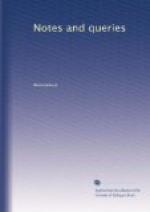2. Is it not quite certain that the acts and decrees of the synod of Wuertzburg, held in the year 1452, were printed in that city previously to the publication of the Breviarium Herbiplense in 1479? The letter Q which is used in the volume of these acts is remarkable for being of a double semilunar shape; and the type, which is very Gothic, is evidently the same as that employed in an edition of other synodal decrees in Germany about the year 1470.
3. When and where was the Liber de Laudibus gloriosissime Dei genitricis Marie semper Virginis, by Albertus Magnus, first printed? I do not mean the supposititious work, which is often confounded with the other one; but that which is also styled Super Evangelium Missus est Quaestiones. And why are these Questions invariably said to be 230 in number, when there are 275 chapters in the book? Beughem asserts that the earliest edition is that of Milan in 1489 (Vid. Quetif et Echard, i. 176.), but what I believe to be a volume of older date is “sine ulla nota;” and a bookseller’s observation respecting it is, that it is “very rare, and unknown to De Bure, Panzer, Brunet, and Dibdin.” {324}
4. Has any discovery made as to the author of the extraordinary 4to. tract, Oracio querulosa contra Inuasores Sacerdotum? According to the Crevenna Catalogue (i. 85.), the work is “inconnu a tous les bibliographes.” Compare Seemiller, ii. 162.; but the copy before me is not of the impression described by him. It is worthy of notice, that at signature A iiiij the writer declares, “nostris jam temporibus calchographiam, hoc est impressioram artem, in nobilissima Vrbanie germe Maguncia fuisse repertam.”
5. Are we to suppose that either carelessness or a love of conjectures was the source of Chevillier’s mistake, not corrected by Greswell (Annals of Paris. Typog., p. 6.), that signatures were first introduced, anno 1476, by Zarotus, the printer, at Milan? They may doubtless be seen in the Opus Alexandride Ales super tertium Sententiarum, Venet. 1475, a book which supplies also the most ancient instance I have met with of a “Registrum Chartarum.” Signatures, however, had a prior existence; for they appear in the Mammetractus printed at Beron Minster in 1470 (Meermau, ii. 28.; Kloss, p. 192.), but they were omitted in the impression of 1476. Dr. Cotton (Typ. Gaz., p. 66.), Mr. Horne (Introd. to Bibliog., i. 187. 317), and many others, wrongly delay the invention or adoption of them till the year 1472.
6. Is the edition of the Fasciculus Temporum, set forth at Cologne by Nicolaus de Schlettstadt in 1474, altogether distinct from that which is confessedly “omnium prima,” and which was issued by Arnoldus Ther Huernen in the same year? If it be, the copy in the Lambeth library, bearing date 1476, and entered in pp. 1, 2. of Dr. Maitland’s very valuable and accurate List, must appertain to the third, not the second, impression. To the latter this Louvain reprint of 1476 is assigned in the catalogue of the books of Dr. Kloss (p. 127.), but there is an error in the remark that the “Tabula” prefixed to the editio princeps is comprised in eight leaves, for it certainly consists of nine.




